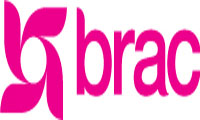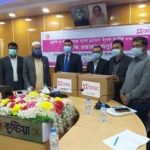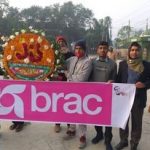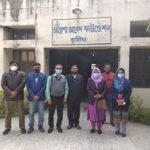 |
BRAC | ||
| 01 | Name and Address of the Organization | ||
|---|---|---|---|
| (a) | Name of Organization | : | BRAC |
| (b) | Address of Head Office | : | BRAC Centre, 75 Mohakhali, Dhaka - 1212 |
| (c) | Address of Liaison Office | : | (If Applicable) |
| (d) | Address of District/Local Office | : | BRAC Regional Office, Jagoti Chinikal Sarak, Chaurhash, Kushtia. |
| 02 | Contact Information | ||
| (a) | Name, Mobile No. & E-mail of ED/CEO | : | Asif Saleh. Phone: 02222281265, E-mail: asif.s@brac.net |
| (b) | Name, Mobile No. & E-mail of Contact Person | : | Amaresh Chandra Das, Mobile No: 01730347440, E-mail: bdc.kushtia@brac.net |
| (c) | Website | : | https://www.brac.net |
| 03 | Date of Establishment | : | 1972 |
| 04 | Registration (Legal Status) | ||
| (a) | Registration of Joint Stock Company & Firm | : | Certification of Registration of Societies ACT XXI of 1860 No. 3695/3 34 (1971-1972) |
| (b) | Registration of NGO Affairs Bureau | : | Number- 002, Date: 22.04.1981 |
| (c) | MRA | : | Sanad No: 00488-00186-00065 , Date:29.11.2007 |
| (d) | : | ||
| 05 | Background of Organization | : | BRAC known formerly as the Bangladesh Rehabilitation Assistance Committee, then as the Bangladesh Rural Advancement Committee, and later as Building Resources Across Communities,BRAC was initiated in 1972 by Sir Fazlé Hasan Abed at Shallah Upazillah in the district of Sunamganj as a small-scale relief and rehabilitation project to help returning war refugees after the Bangladesh Liberation War of 1971.14 thousand homes had to be rebuilt as part of the relief effort, as well as several hundred fishing boats; BRAC claims to have done this within nine months, as well as opening medical centres and providing other essential services. Until the mid-1970s, BRAC concentrated on community development through village development programmes that included agriculture, fisheries, cooperatives, rural crafts, adult literacy, health and family planning, vocational training for women and construction of community centres. A Research and Evaluation Division (RED) was set up to evaluate its activities and decide direction, and in 1977, BRAC began taking a more targeted approach by creating Village Organisations (VO) to assist the landless, small farmers, artisans, and vulnerable women. That same year BRAC set up a commercial printing press to help finance its activities. The handicraft retail chain called Aarong was established the following year In the late 1970s, diarrhoea was a leading cause of child mortality in Bangladesh.In February 1979, BRAC began a field trial, in two villages of what was then Sulla thana, of a campaign to combat diarrhea. The following year they scaled up the operation and named it the Oral Therapy Extension Programme (OTEP). It taught rural mothers in their homes how to prepare an oral rehydration solution (ORS) from readily available ingredients and how to use it to treat diarrhoea The training was reinforced with posters and radio and TV spots. The ten-year programme taught 12 million households spread over 75,000 villages in every part of Bangladesh except the Chittagong Hill Tracts (which were unsafe to work in because of civil unrest). Fifteen years after they were taught, the vast majority of mothers could still prepare a safe and effective ORS. The treatment was little known in Bangladesh when OTEP began, but 15 years later it was used in rural households for severe diarrhoea more than 80% of the time, one of the highest rates in the world. Non Formal Primary Education was started by BRAC in 1985. In 1986, BRAC started its Rural Development Programme that incorporated four major activities – institution building including functional education and training, credit operation, income and employment generation and support service programmes. In 1991, the Women's Health Development programme commenced. The following year BRAC established a Centre for Development Management (CDM) in Rajendrapur. Its Social Development, Human Rights and Legal Services programme was launched in 1996. In 1998, BRAC's Dairy and Food project was commissioned. BRAC launched an Information Technology Institute the following year. In 2001, BRAC established a university called BRAC University. |
| 06 | Vision | : | A world free from all forms of exploitation and discrimination where everyone has the opportunity to realise their potential. |
| 07 | Mission | : | Our mission is to empower people and communities in situations of poverty, illiteracy, disease and social injustice. Our interventions aim to achieve large scale, positive changes through economic and social programs that enable women and men to realise their potential. |
| 08 | Goal | : | |
| 09 | Objectives | : | |
| 10 | Target people | : | BRAC aims to reach at least 250 million disadvantaged women (and their dependents), youth, and people living in poverty around the world, including Bangladesh, within the next 10 years. |
| 11 | Major activities | : |
1. BRAC Education Program (BEP) 2.Health, Nutrition & Population program (HNPP). 3. Communicable Disease Control Program (TB) 4. Skill Development Programme. 5.Micro finance program (Dabi, Progoti,BCUP & SCDP) 6. Farmers Capacity Development Program. 7. Ayesha Abed Foundation. 8. Artificial Insemination . 9. BRAC Seed Farm. |
| 12 | Working Area (Name of Upazila & District) | : |
Six Upazilas in Kushtia District: (1) Kushtia sadar, (2) Kumarkhali, (3) Khoksha, (4) Mirpur, (5) Bharamara, (6) Daulatpur. |
| 13 | List of Executive Committee | : |
1. Asif Saleh, Executive Director, BRAC Bangladesh. 2. Tamara Hasan Abed, Managing Director, Enterprises, BRAC. 3. Shameran Abed, Executive Director, BRAC International 4. Tushar Bhowmik, Chief financial Officer, BRAC, Bangladesh. 5. KAM Morshed, Senior Director, Advocacy, SIL, Technology & MEAL. 6. Nelly Enwerem-Bromson, Senior Director, Global Resourch Mobilisation and Partnership, BRAC and BRAC International. 7. Syed Abdul Muntakim, Chief Finance and Risk Officer. BRAC International. 8. Gregory Chen, Managing Director, Ultra-Poor Graduation Initiative, BRAC International. 9. Arinjoy Dhar, Senior Director, Microfinance, BRAC. |
| 14 | Photo Gallery | : |
|
| 15 | Others | : | |





